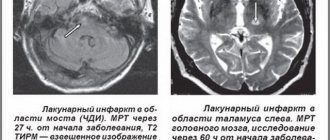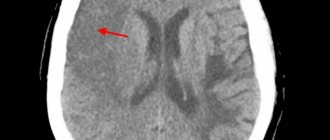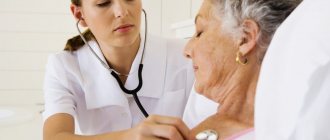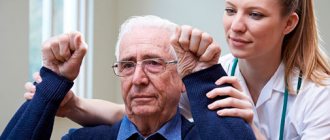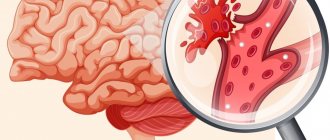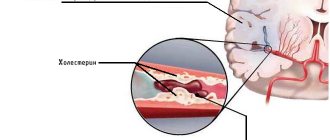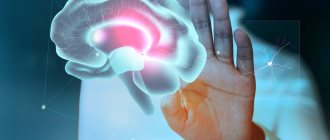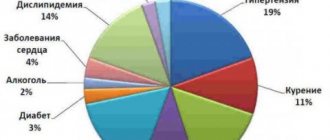Stroke, or acute cerebrovascular accident, remains one of the leading causes of death. Practice shows that in 60% of cases the lesion is localized in the left brain structures, which control the activity of the right half of the body, where paralysis occurs. Just a few minutes of stopping blood flow is enough to kill millions of neurons and create a dead zone in the nervous tissue. The pathological process involves the pathways of CNS signals to systems and organs on the right.
Kinds
Neurology defines two types of stroke with paralysis of the right side:
- Ischemic stroke. Occurs due to blockage of cerebral vessels by atherosclerotic plaques and blood clots. In the area of circulatory arrest, a focus of brain tissue necrosis occurs. The severity of subsequent paralysis and the ability of the central nervous system to compensate for lost functions depend on its location and size. The disease most often threatens hypertensive patients, diabetics, smokers and anyone with high cholesterol, thrombophlebitis, blood thickening, or problems with heart rhythm. Attacks of tachycardia or atrial fibrillation can provoke the formation of blood clots in the heart cavity, which enter the brain vessels with the blood flow. This type of stroke develops over 2-3 days or longer, so it has specific diagnostic features.
- Hemorrhagic stroke. It is characterized by a rupture of the vascular wall and a breakthrough of blood into the brain tissue, which dies from ischemia. It is provoked by a hypertensive crisis, specific aggregate states of the blood, diseases that cause pathological changes in the structure of blood vessels. Hemorrhagic stroke develops rapidly, quickly causing a coma in the patient. This diagnosis entails the most severe consequences.
The practice of neurology shows that strokes with paralysis of the right side are easier and the consequences are eliminated faster. This is explained by the fact that ischemic stroke more clearly manifests the onset of the disease with characteristic signs.
Make an appointment
What is ischemic and hemorrhagic stroke
Based on etiology, right-sided stroke is divided into ischemic and hemorrhagic. The first develops due to impaired cerebral blood flow on the right due to narrowing of blood vessels or their complete blockage; the speed of blood movement and its viscosity also play a role. As a result, hypoxia of brain cells is provoked with their death and necrosis of a certain area of the brain. Symptoms of ischemic stroke increase gradually, so ischemia develops over several hours or even days, which makes it possible to consult a doctor in a timely manner and avoid fatal consequences. The prognosis for this form of the disease is affected only by the extent of the lesion (necrosis).
Hemorrhagic stroke is a hemorrhage in brain tissue due to rupture of blood vessels. Often this situation leads to cerebral edema, coma and death. Vascular rupture occurs much less frequently, but has more severe consequences, since there is no time to “build up”. The spilled blood permeates the tissues, compresses vital structures, sometimes completely destroying them. Regardless of the size of the affected area of the brain, nerve cells are restored slowly; not all lost functions of the nervous system can be restored.
Types of paralysis on the right side
According to the nature and localization of vascular accidents, the types and subtypes of paralysis are classified:
- Central paralysis. It develops when the areas of the brain and spinal cord responsible for the function of movement and the state of the neuromuscular complex are damaged. Characterized by specific spastic reactions. With the central form of paralysis, all muscles are affected, which are in constant tension, and when calm they show clonus - rhythmic twitching, mainly in the area of the knees and feet. In many areas, diagnostic reflexes are absent or weakened.
- Peripheral paralysis. With this type of stroke, a decrease or absence of neurological reflexes develops. The tone in the muscles is not determined, they atrophy, decrease in mass, patients lose the ability to move, self-care and generally do any activity. The main task is to restore the conduction pathways of impulses from the brain and spinal cord to the neuromuscular system. By the nature of the pathological symptoms and the areas of their location, it is possible to determine which segments of the central nervous system are out of order.
Causes
The main cause of right-sided paralysis is strokes, chronic and then acute disturbances of blood supply in the structures of the left hemisphere.
A stroke is not a disease that happens suddenly. Its causes accumulate over years, decades, so that when a critical point is reached, one day the scenario of a “vascular catastrophe” unfolds. This leads to:
- Physical inactivity;
- Diet with a predominance of animal fats and proteins;
- Metabolism, carbohydrate and cholesterol status disorders;
- Limited or inadequate sleep;
- Abuse of tobacco, alcohol, drugs;
- Chronic or severe one-time stress.
Eliminating at least half of these causes will allow stroke to be removed from the list of major diseases that most often suffer in our time.
Expert opinion
Author: Ekaterina Dmitrievna Abramova
Neurologist, director of the chronic pain clinic
According to the Federal State Statistics Service, stroke ranks second in the structure of mortality. This is a dangerous neurological disease, the incidence of which is increasing every year. Statistics show that acute cerebrovascular accident occurs in every third person per 1000 population. Stroke in 60% of cases leads to disability. Due to severe complications, 10% of patients completely lose the ability to self-care. The appearance of persistent paralysis is associated with extensive brain damage.
A stroke requires immediate diagnosis and correct treatment. At the Yusupov Hospital, examinations are carried out using the latest medical equipment: CT, MRI. Thanks to them, it is possible to accurately determine the location of the pathological focus. Doctors at the Yusupov Hospital develop an individual treatment and rehabilitation plan for each patient. The drugs are selected in accordance with the latest European recommendations for the treatment of strokes. Conservative treatment can be supplemented with surgical intervention if indicated. In addition, to speed up recovery, physiotherapy and a course of physical therapy are prescribed.
Consequences of ischemia
With a small area of necrosis of brain tissue or a micro-stroke on the right, the prognosis for the patient’s life is favorable: neurological changes are minimal and do not criminally impair brain function. An exception is trunk ischemia, since vital centers - respiratory and cardiovascular - are concentrated here. Therefore, even a microstroke of the brain stem almost 100% ends in death in the first hours.
The remaining patients will experience disability because, although they are not completely bedridden, they lose even a small ability to adequately, fully perceive the surrounding reality, understand what is happening to them, and the ability to think logically. For left-handed people it’s the other way around. For them, the consequences of a right-sided stroke are similar to ischemia of the left hemisphere in right-handed people.
The main consequences are presented in the table. We must understand that the consequences of ischemic stroke decrease over time with proper treatment. About a quarter of patients under 55 years of age recover fully from a microstroke without visible signs of any neurological impairment.
At the same time, no matter how many functions are rehabilitated in the first two years after a micro-stroke, so many will remain until the end of days. Nerve cells are practically not restored.
| Outcome of stroke on the right | Consequences of micro and macro ischemic stroke |
| Complete paralysis of the left side of the body | The movements of the left limbs are minimized, the position is half-bent, the patient is able to sit, but without assistance he is not able to walk or grasp objects with his hand (hemiplegia) |
| Imbalance of sensitivity on the left | Pain and temperature threshold increases (hypoesthesia) |
| Loss of sense of spatial arrangement of arms and legs | |
| Mental disorders | Criticism decreases, foolish behavior arises, speech becomes inadequate, the person becomes aggressive |
| Memory loss | Patients remember the past, but forget what they did an hour ago; temporary complete amnesia and disorientation in space and time are possible |
| Left vision disorders | Decreased vision up to blindness, double vision, turning the head and left eye to the left |
If the area of brain necrosis is large (massive stroke), the prognosis is disappointing: up to 70% of patients die in the first few days, others become deeply disabled. The consequences are:
- persistent paralysis: patients cannot even sit;
- cerebral coma;
- complete lack of criticism and thinking;
- swallowing disorders.
Symptoms
The signs of the onset of an illness are beyond doubt; not only doctors, but also ordinary people should know them in order to help their loved ones, acquaintances, or just a person on the street who has become ill in time. You should call the emergency room immediately if you experience the following symptoms:
- Sudden loss of speech (or when it becomes slurred);
- Inability to move an arm or leg;
- Inability to smile (the right side of the mouth sags);
- drooping eyelid;
- State of stupefaction, spatial and temporal disorientation, the patient complains of “mess in the head”;
- Severe headache with vomiting, dizziness;
- The extended right leg turns the foot inward;
- The right arm is bent and pressed towards the body.
How to treat
Treatment for ischemic stroke on the right side of the brain begins only after the diagnosis is confirmed. The doctor draws up an action plan based on the results of the examination.
Recognition methods
Diagnosis of right-sided ischemic stroke is quite simple. You need to ask the person to perform 3 actions: smile, raise both hands at the same time, say your name.
A person will not have a full smile, since the corner of the lips will be pulled down. One arm will be weaker than the other, as a result of which he will not be able to lift both of them up. He is not able to pronounce even a simple name.
If there are difficulties with at least 2 steps, you must immediately contact an ambulance. The doctor has just over 4 hours to save the victim.
Post-stroke speech dysfunction
Speech plays one of the most important roles in human life. Certain areas of the cerebral cortex are responsible for the speech apparatus. Damages to brain structures, which include acute circulatory disorders, lead to serious disorders. A person who has had a stroke:
- puts words in the wrong order;
- cannot remember the names of objects;
- does not understand the people who approached him;
- cannot pronounce some sounds;
- loses the ability to express his thoughts clearly.
Speech impairment is long-term, but can be corrected. There are also cases when speech is restored gradually on its own. Unfortunately, this happens extremely rarely, and the patient cannot do without rehabilitation under the supervision of doctors and relatives.
Why is speech function impaired?
A person's inability to speak clearly after a stroke is called aphasia. This condition is the result of:
- rupture of neural connections;
- severe disruption of neuronal nutrition;
- hematoma pressure on nerve tissue.
Based on the complexity of the lesion, it is possible to predict how quickly the patient will recover speech after a stroke. The extent of the lesion also plays a key role: the larger it is, the more complex the aphasia. In addition, the main criteria affecting the restoration of articulation include:
- affected area;
- timeliness of treatment;
- quality of rehabilitation measures.
Types of speech disorders
When a blood vessel ruptures in the brain, speech functions are first affected. With hemorrhage, various articulation disorders appear. In addition to aphasia, there are other types of speech dysfunction:
- dysarthria;
- dyspraxia.
How to restore speech abilities after a stroke
One of the main roles in the process of acquiring lost speech abilities is played by early access to a doctor. Help for the patient should be provided in the first hours after a stroke. It is also important to establish which aspects of speech have been damaged. The specialist must conduct diagnostic tests on the basis of which he makes a conclusion.
Rehabilitation methods for improving speech after cerebral hemorrhage are presented:
- taking certain medications;
- exercises to restore pronunciation;
- speech therapy;
- additional measures: surgery, physiotherapy, massage.
The success of rehabilitation also depends on the general environment in which the patient lives. He needs a peaceful atmosphere, away from noise and harsh sounds. Stress and worry will only slow down your recovery.
Treatment
Thanks to the efforts of healthcare organizers, the system of stroke treatment in Russia has undergone positive changes. It has become the norm to transport patients with suspected cerebral circulatory disorders to an intensive care bed or neurosurgeon's table within three hours.
Treatment for stroke, when the right side is paralyzed, begins in the intensive care unit, where patients are hospitalized urgently. The treatment regimen provides for the normalization of blood circulation in the brain, restoration of respiratory and swallowing functions, and elimination of the threat of convulsive phenomena.
The treatment regimen for hemorrhagic stroke with paralysis of the right side is somewhat different. In this case, drugs that eliminate thromboembolism come to the fore. If treatment is started on time, the blood clot is destroyed and impaired blood flow is restored. Thanks to modern medications, it is often possible to completely avoid the consequences of a stroke.
The patient's condition requires normalization of homeostasis, a decrease in the degree of permeability of the vascular walls and the formation of plasmin. In some cases, blood clots from brain vessels are removed surgically in neurosurgery departments.
Prevention of strokes
Hereditary predisposition to stroke, the presence of cardiac diseases, pathology of blood vessels and blood composition, age over 40 years, obesity and diabetes require a number of preventive measures:
- Maintaining normal blood pressure, taking antihypertensive drugs as prescribed by a doctor, monitoring blood pressure.
- Maintaining a normal level of physical activity, exercise, walking 30-40 minutes a day (for example, walking the dog).
- Conducting preventive examinations, including a standard set of laboratory parameters. During a preventive examination, the following tests are additionally required: gene diagnosis of CADASIL syndrome using the PCR method, plasma factors of the blood coagulation system, antibodies to prothrombin of the IgG and IgM classes to determine the risk of thrombosis, determination of polymorphisms associated with the risk of arterial hypertension, diabetes mellitus, lipid disorders exchange, in order to identify a predisposition to diseases that increase the risk of stroke, von Willebrand factor (a glycoprotein that ensures the formation of blood clots), complex laboratory tests for preclinical diagnosis of cardiovascular diseases are offered (“ELI-ANKOR-Test-12”, “Cardiorisk”).
- Avoiding chronic and acute stress, maintaining mental hygiene.
- Normalization of weight (BMI <25 kg/m2).
- Healthy eating (for example, Mediterranean diet, limiting salt to 5 5 g/day).
- Quitting smoking and taking psychoactive substances.
- Treatment of diseases that are a risk factor for stroke [8, 11].
Lifestyle
Stroke is a disease in which a person must start life in new conditions. Most people find it difficult to accept their condition, so deep depression is as dangerous a complication as the physical manifestations. Already in the first stages of recovery, much attention is paid to this aspect.
The scientific, material and technical base of the Yusupov Hospital allows patients to undergo rehabilitation procedures using modern equipment that meets European standards.
Therapy for right-sided paralysis
The outcome of treatment is more favorable the earlier the patient was hospitalized. A stroke in which the right side is paralyzed requires the following measures:
- Emergency correction of disorders of such important functions as breathing, blood movement through the vessels, swallowing. This also includes interruption of status epilepticus.
- Regulation of water-electrolyte balance and prevention of cerebral edema.
- Neuroprotective therapy aimed at protecting the brain from metabolic disorders.
Right side massage
Recovery after a stroke with paralysis of the right side with the help of massage begins on the 20th day of illness. This is an average date; the severity of the patient’s condition, age, concomitant diseases, etc. are taken into account.
The first massage sessions begin with gentle stroking of the limbs, back and neck muscles. The intensity of the effect increases from session to session, the massage therapist’s actions are aimed at restoring normal blood circulation and sensitivity in the affected part of the body.
Rehabilitation
The main goal of rehabilitation after a stroke is the return of movements in the right side of the body, speech and other cognitive abilities. First of all, the patient is recommended to follow a certain diet, go to massage, physiotherapy and consult a speech therapist.
Diet
In order for blood flow and other body systems to recover faster, you need to limit yourself to certain foods and focus on healthier foods. The body must receive all the necessary substances with food to restore damaged tissues.
dieta-after-insulta
When preparing a diet, you should adhere to a number of conditions:
- do not eat smoked meats or foods high in fat;
- meat products should be consumed lean, in small quantities (preferably in crushed form) and only after consultation with a doctor;
- eat more fresh fruits and vegetables;
- do not drink drinks high in caffeine, sugar or alcohol;
- eat food often, but in small quantities.
In case of serious consequences of a stroke, the products should be selected by a nutritionist, taking into account the patient’s health and level of energy consumption.
Massage
Massage is necessary to prevent the formation of bedsores, so it is prescribed from the very beginning on a daily basis. During the procedure, the entire right side of the body is warmed up. This helps normalize blood flow, molecular processes in cells and joint functions.
Therapeutic massage of the paralyzed part includes:
- stroking the body from the limbs towards the blood flow;
- rubbing the skin is carried out in the same direction, but more actively;
- creating vibration in the softest places;
- repeated stroking at the end of the session.
You can avoid the development of bedsores if you carry out similar actions every day. It is also important to frequently shift the patient, changing his position, and rub with alcohol (if there are no skin disorders).
Physiotherapy
Physical therapy is prescribed after 2 or 3 weeks from the moment of the stroke, if the patient is clearly on the mend. Physical education is prescribed to achieve a number of goals:
- reducing the risk of muscle atrophy;
- increasing the ability of nerve tissue to transmit impulses to muscles;
- regaining the ability to control the body and take care of oneself independently.
lechebnaya-fizkultura
The most effective physical therapy is prepared by a specialist who can select exercises to restore certain abilities.
Fighting bedsores
Bedsores are a dangerous enemy of bedridden patients who have to remain in bed for long periods of time. Bedsores appear in areas that are subject to the greatest pressure - the tailbone, shoulder blades, buttocks, legs, forearms.
Bedsores in advanced stages require surgical treatment. There are cases when a patient was saved in intensive care, but then, due to poor care, he died from sepsis that developed from banal bedsores. Nursing after a stroke is exactly the case when an experienced and conscientious nurse is just as important as a doctor. And sometimes it’s even more important.
The main thing is to see a doctor in time
The doctor who treats strokes is a neurologist. He takes part in the restoration of lost mental and physical functions. The main tasks of a specialist when working with patients who have already been discharged from the hospital are secondary prevention, which is aimed at preventing a recurrent attack, as well as drug treatment of the consequences of the “stroke”.
A modern method for diagnosing pathology is ultrasound duplex scanning of neck vessels. An image of the vessel is formed, its patency and structure are displayed. Diagnostics allows timely detection and prevention of vascular diseases, including stroke.
You need to undergo the study if:
- frequent fainting, headaches, dizziness;
- hypertension;
- arrhythmias;
- elevated cholesterol levels;
- traumatic brain injuries;
- sleep, vision and hearing disorders;
- weakened attention, memory loss.
The necessary studies are prescribed by a neurologist. Based on diagnostic data, treatment is prescribed, which varies depending on the type of stroke.
Our clinic address: St. Petersburg, st. Bolshaya Raznochinnaya, 27 metro station Chkalovskaya
How long does it take for speech to be restored?
Rehabilitation of speech functions usually begins a week after the rupture of a blood vessel in the brain, provided that the patient’s condition is stable. However, there are situations when the patient is not able to start exercising even after a month. One way or another, rehabilitation therapy should begin no later than two months later. Otherwise, it will be much more difficult to regain lost abilities.
It is very difficult to give an accurate forecast regarding the time of speech recovery after a stroke. Rehabilitation is a step-by-step process with a clear sequence. The duration of each stage varies and is individual for each patient. On average, the maximum improvement in speech abilities is observed in the first six months after the illness. The entire recovery period lasts from three to five years.
Complications
Neurologists have to deal with numerous complications of the physical and psychological state of a stroke, which include:
- Gross disturbances of mental, cognitive, speech activity;
- Perceptual inhibition;
- Inflammatory phenomena of the bronchopulmonary, genitourinary system due to congestion in an immobilized patient;
- Depressive states with suicidal statements.
These manifestations require the closest attention and active therapy from specialists in various fields.
The Yusupov Hospital has a full range of rehabilitation equipment, including innovative ones, and a staff of highly qualified specialists who are proficient in modern techniques and types of massage and physical therapy. Their efforts, led by the country's best neurologists, are helping people recover from stroke paralysis.
What are the features of a left hemisphere stroke?
As we said above, the left hemisphere of the brain controls the right half of the human body. If the left hemisphere of the brain is damaged, paresis (paralysis) of the right limbs will be noted.
The left hemisphere also controls speech (for all right-handers and half of left-handers, and for the other half of left-handers, the center of speech is located in the right hemisphere of the brain), memory and cognitive functions, so during a stroke the patient may have problems with speech, he will lose memory, and mood swings, behavior will change - he will become slow and cautious.


